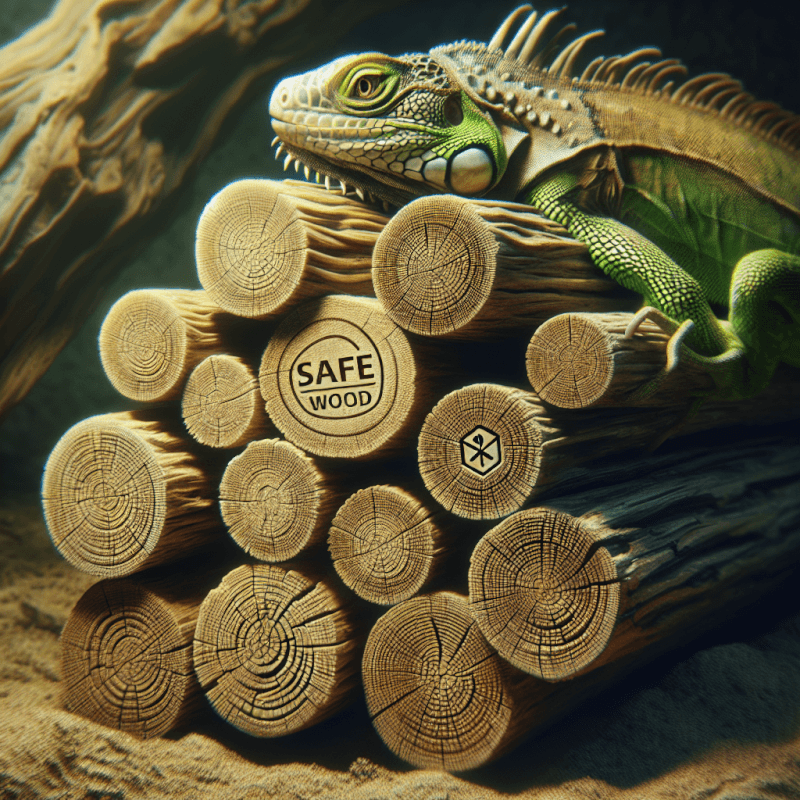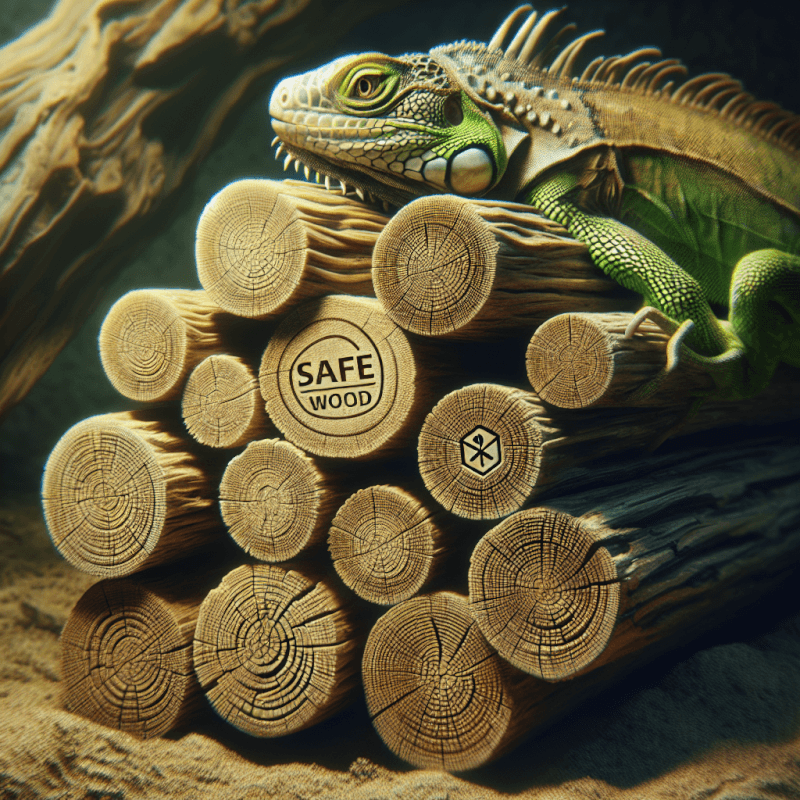Have you ever wondered what kind of wood is safe to use for your reptile’s enclosure? Choosing the right type of wood is crucial to ensure the health and safety of your scaly friend. In this article, we will explore different types of wood that are suitable for reptile enclosures, discussing their qualities, benefits, and potential drawbacks. By the end, you’ll have a better understanding of which wood is best for creating a comfortable and secure habitat for your beloved reptile.
Types of Wood to Avoid
Cedar
Cedar is a common wood used in outdoor applications due to its natural resistance to rot and insects. However, it is not suitable for reptile enclosures. Cedar contains oils and aromatic compounds that can be toxic to reptiles, especially in confined spaces. These toxic properties can harm the respiratory and nervous systems of your reptile, making it an unsafe choice for their enclosure.
Pine
Pine is another type of wood that should be avoided when building reptile enclosures. Like cedar, pine also contains natural oils and chemicals that can be harmful to reptiles. The volatile organic compounds (VOCs) released by pine can irritate their respiratory system and cause respiratory distress. To keep your reptile safe and healthy, it is best to steer clear of pine wood for their enclosures.
Redwood
Redwood may be a beautiful and durable wood, but it is not suitable for reptile enclosures. Similar to cedar and pine, redwood contains natural oils and tannins that can be toxic to reptiles. These toxic substances can cause skin irritation, respiratory issues, and even organ damage in some cases. It’s important to prioritize the safety and well-being of your reptile, so avoid using redwood in their enclosure.
Fir
Fir is a common type of wood used in construction, but it is not recommended for reptile enclosures. Fir wood tends to be softer and less durable compared to other types of wood, meaning it may not hold up well in the humid and sometimes harsh conditions of a reptile enclosure. Additionally, fir wood is more susceptible to mold and mildew growth, which can pose health risks to your reptile. It’s best to choose a more suitable wood option for their enclosure.
Safe Wood Options
Oak
Oak wood is a safe and popular choice for reptile enclosures. It is known for its durability and strength, making it able to withstand the wear and tear of a reptile habitat. Oak wood is also relatively low in resin content, making it less likely to release toxic substances that could harm your reptile. Its natural beauty and grain patterns add an aesthetic appeal to the enclosure as well.
Birch
Birch wood is another safe option for reptile enclosures. It is a hardwood with a fine grain, making it both durable and aesthetically pleasing. Birch wood is known for its resistance to splitting and warping, making it suitable for the varying humidity levels in a reptile habitat. It is also low in resin content, reducing the risk of harmful volatile compounds being released into the enclosure.
Maple
Maple wood is commonly used in furniture and cabinetry due to its strength and durability. This makes it a suitable choice for reptile enclosures as well. Maple wood is relatively low in resin content, making it safe for reptiles. Its light color and smooth grain also provide an attractive and natural look to the enclosure.
Beech
Beech wood is a safe and versatile option for reptile enclosures. It is a hardwood that is known for its strength and resistance to wear. Beech wood has a low resin content, reducing the risk of releasing harmful toxins into the enclosure. It also has a smooth and even grain, making it aesthetically pleasing in reptile habitats.
Hickory
Hickory wood is a strong and durable option for reptile enclosures. It is known for its resistance to moisture and decay, making it suitable for the humid conditions within a reptile habitat. Hickory wood has a high hardness rating, preventing it from easily splintering or breaking. However, it’s important to note that some reptiles, such as desert-dwelling species, may prefer a drier environment, in which case hickory may not be the best choice.
Mahogany
Mahogany wood is a popular choice for furniture and cabinetry due to its rich color and beautiful grain patterns. It is also a safe option for reptile enclosures. Mahogany is a hardwood with low resin content, making it safe for reptiles. Its durability and resistance to warping make it suitable for the varying humidity levels of a reptile habitat. However, mahogany can be quite expensive compared to other wood options.
Cherry
Cherry wood is known for its warm color and attractive grain patterns, making it a visually appealing choice for reptile enclosures. It is also a safe wood option. Cherry wood has a low resin content, reducing the risk of toxic substances being released into the enclosure. However, it is important to note that cherry wood can darken over time when exposed to UV light, so it may require regular maintenance and refinishing.
Poplar
Poplar wood is a safe and affordable option for reptile enclosures. It is a hardwood that is readily available and easy to work with. Poplar wood has a low resin content, minimizing the risk of toxic substances being released into the enclosure. Its light color and smooth grain make it a versatile choice for various reptile habitat designs.
Bamboo
Bamboo is a unique and eco-friendly option for reptile enclosures. It is actually a grass rather than a wood, but it is often used as a wood substitute. Bamboo is known for its strength and durability, making it suitable for reptile habitats. It is also a sustainable material, as it grows rapidly and can be harvested without harming the plant. However, it is important to ensure that the bamboo is properly treated and sealed to prevent any potential issues.

Factors to Consider
Toxicity
When selecting wood for a reptile enclosure, it is crucial to consider the toxicity of the wood. Certain types of wood, such as cedar and pine, contain natural oils and chemicals that can be harmful to reptiles. These toxic substances can cause respiratory issues and even organ damage in some cases. Opting for woods with low resin content, such as oak and birch, can help minimize the risk of toxicity to your reptile.
Durability
Reptile enclosures should be built to withstand the wear and tear of a reptile’s natural behaviors. Choosing a wood that is durable and strong is essential in ensuring the longevity of the enclosure. Hardwoods like oak and hickory are known for their strength and resistance to damage, making them suitable choices for reptile enclosures. Softer woods like fir may not hold up as well over time.
Moisture Resistance
Reptile habitats require specific humidity levels to replicate their natural environment. Choosing a wood that is resistant to moisture is important in preventing damage to the enclosure. Hardwoods like hickory and mahogany are known for their ability to resist moisture and decay. It is important to take into account the specific humidity needs of your reptile when selecting a wood with the appropriate resistance to moisture.
Ease of Cleaning
Reptile enclosures can quickly become dirty and require regular cleaning. Selecting a wood that is easy to clean and maintain is beneficial for both you and your reptile. Smooth-grained woods like maple and beech are easier to wipe clean compared to woods with rougher textures. Additionally, it is important to consider whether the wood will absorb odors or stains, as this may affect the cleanliness of the enclosure.
Treatment and Preparation
Avoid Treated Wood
Treated wood, such as pressure-treated or chemically treated wood, should be avoided for reptile enclosures. These types of wood are treated with chemicals that are designed to protect against rot and insect damage. However, the chemicals used in the treatment process can be harmful to reptiles. It is best to opt for untreated wood to ensure the safety of your reptile.
Heat Treatment
Heat treatment is a process that involves heating the wood to a specific temperature to eliminate pests and reduce moisture content. This can make the wood safer for use in reptile enclosures. Heat-treated wood is often labeled as “kiln-dried” or “heat-treated.” It is important to ensure that the wood has been heat-treated to a proper temperature to effectively eliminate any potential pests or mold.
Sand and Seal
Before using any type of wood in a reptile enclosure, it is recommended to sand it down and seal it. Sanding the wood helps to smooth out any rough surfaces, reducing the risk of splintering. Sealing the wood with a reptile-safe sealant helps to protect it from moisture and makes it easier to clean. Make sure to use a non-toxic sealant to ensure the safety of your reptile.

Benefits of Wood in Reptile Enclosures
Natural Aesthetics
One of the main benefits of using wood in reptile enclosures is the natural aesthetics it provides. Wood creates a visually appealing and natural-looking habitat for your reptile. The various grains and colors of different wood types can enhance the overall appearance of the enclosure, creating a more inviting environment for your reptile.
Insulation Properties
Wood has natural insulation properties, making it a suitable material for reptile enclosures. It helps to retain heat and maintain a stable temperature within the enclosure, which is crucial for reptiles that rely on external heat sources to regulate their body temperature. Wood also provides some insulation against noise, creating a more comfortable living space for your reptile.
Risks and Considerations
Wood Rot
One of the main risks associated with using wood in reptile enclosures is wood rot. Reptile habitats can be humid environments, which can promote the growth of mold and fungi, leading to wood rot. Choosing a wood with natural resistance to moisture, such as hickory or mahogany, can help mitigate the risk of wood rot. Regular maintenance and monitoring of the enclosure’s humidity levels are also essential in preventing wood rot.
Splintering
Some types of wood, especially softer ones like pine or fir, may be prone to splintering. Splinters can pose a safety hazard to your reptile, potentially causing injuries. Opting for hardwoods with a high hardness rating, such as oak or hickory, can help reduce the risk of splintering. Additionally, sanding and sealing the wood can smooth out rough surfaces and minimize the chance of splinters.
Mold and Mildew
The humid conditions of reptile enclosures can promote the growth of mold and mildew on wood surfaces. This can be a health risk for your reptile and compromise the durability of the enclosure. Choosing woods with natural resistance to mold and mildew, such as hickory or maple, can help prevent this issue. It is also important to regularly clean and monitor the enclosure for any signs of mold or mildew growth.
Parasites
Wood can potentially harbor parasites or pests that could pose a threat to your reptile’s health. Using heat-treated wood and ensuring proper preparation and maintenance can help minimize the risk of parasite infestation. Regularly inspecting the enclosure and promptly addressing any signs of pests is crucial in keeping your reptile safe and healthy.

Additional Safety Measures
Avoid Sharp Edges
When using wood in reptile enclosures, it is important to avoid any sharp edges or splintered areas that could potentially harm your reptile. Sanding down the wood and rounding off any sharp corners can help prevent injuries. Regularly inspecting the enclosure for any signs of damage or wear and addressing them promptly is essential in maintaining a safe environment for your reptile.
Regular Maintenance
Wooden reptile enclosures require regular maintenance to ensure their longevity and the safety of your reptile. This includes monitoring the humidity levels, cleaning the enclosure, and inspecting for any signs of damage or wear. Regularly checking for mold, mildew, or pests is also crucial. Keeping up with routine maintenance tasks will help prevent any potential issues and maintain a healthy and safe environment for your reptile.
Monitoring and Observation
Monitoring your reptile and regularly observing their behavior and health is essential in ensuring their safety in a wooden enclosure. Look out for any signs of distress, unusual behavior, or respiratory issues that could indicate a problem with the wood or the environment. If you notice any concerns, it is important to address them promptly to keep your reptile safe and healthy.
Alternative Enclosure Materials
Melamine
Melamine is a popular alternative to wood for reptile enclosures. It is a durable and easy-to-clean material that is resistant to moisture and staining. Melamine enclosures are often customizable and can be easily assembled. However, it is important to choose a melamine product that is free from formaldehyde, as this can be toxic to reptiles.
PVC
PVC (polyvinyl chloride) is another alternative material used in reptile enclosures. It is lightweight, durable, and resistant to moisture. PVC enclosures are easy to clean and maintain, making them a convenient option for reptile owners. However, it is important to ensure that the PVC used is safe for the reptile and does not contain any harmful chemicals.
Glass
Glass enclosures are a popular choice for reptiles, especially for species that require high humidity or have specific heating needs. Glass allows for excellent visibility and easy monitoring of the reptile. However, glass enclosures may have limited ventilation and can be heavy and difficult to move or clean.
Acrylic
Acrylic is a lightweight and shatter-resistant material that is commonly used for reptile enclosures. It provides good visibility and is easy to clean. Acrylic enclosures are customizable and can be constructed to meet specific requirements. However, acrylic can scratch easily, and proper care must be taken to avoid damage.
Metal
Metal enclosures, such as those made from aluminum or stainless steel, can be a durable and long-lasting option. They provide good ventilation and are easy to clean and maintain. Metal enclosures are often used for larger reptiles or those with specific temperature and humidity needs. However, it is important to ensure that the metal used is non-toxic and does not contain any harmful coatings.

Conclusion
When choosing wood for a reptile enclosure, it is important to prioritize the safety and well-being of your reptile. Avoiding toxic woods like cedar, pine, redwood, and fir is crucial in preventing harm to your reptile’s respiratory and nervous systems. Opting for safe wood options such as oak, birch, maple, beech, hickory, mahogany, cherry, poplar, or bamboo is recommended.
Factors such as toxicity, durability, moisture resistance, and ease of cleaning should be considered when selecting the wood for a reptile enclosure. Treating and preparing the wood by avoiding treated wood, heat treatment, and sanding and sealing can further enhance its suitability for reptile habitats.
Wooden enclosures offer natural aesthetics and insulation properties, but they also pose certain risks and considerations such as wood rot, splintering, mold and mildew, and parasite infestation. Taking additional safety measures such as avoiding sharp edges, regular maintenance, and monitoring and observation can help mitigate these risks.
For those who prefer alternative materials, options like melamine, PVC, glass, acrylic, or metal can be considered. Ultimately, the choice of enclosure material should be based on the specific needs and preferences of your reptile, while ensuring their safety and well-being.


